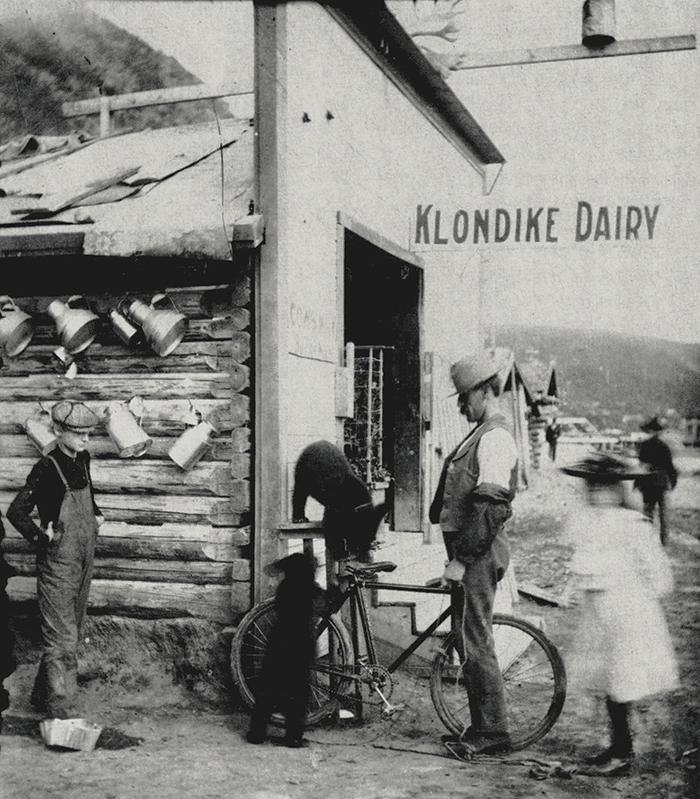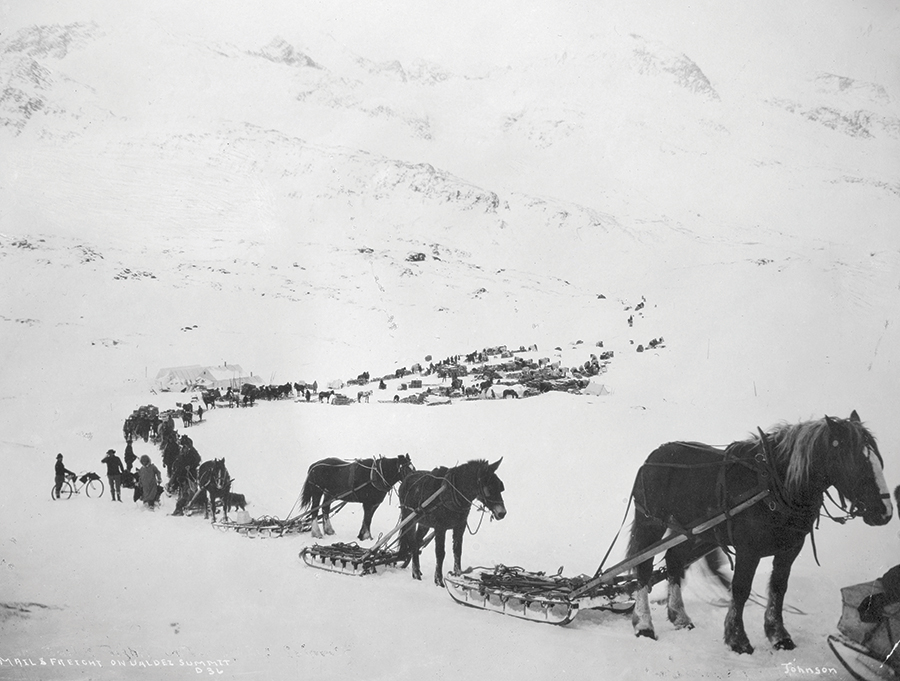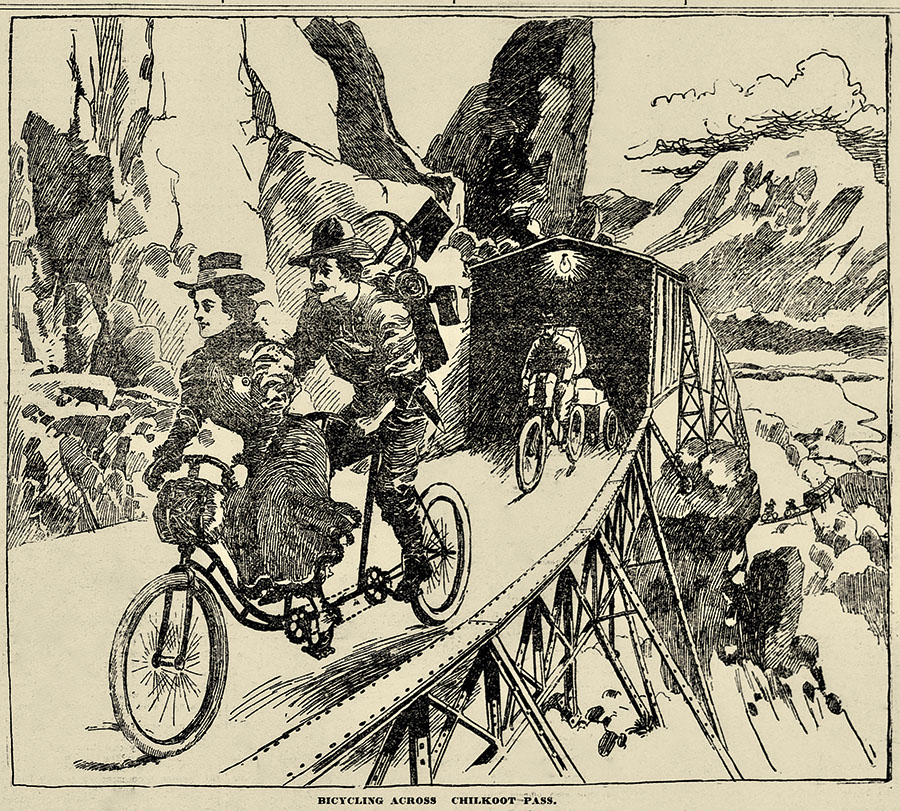Wheels to Fortune
This article first appeared in the June 2021 issue of Adventure Cyclist magazine.
In late February, as the days grow longer and somewhat milder, down-clad athletes flock to western Alaska for the Iditarod Trail Invitational. “The world’s longest and toughest winter race,” like the famous mushing event, honors a roughly thousand-mile, life-saving 1925 serum run from Seward to Nome. Fat biking, running, and skiing, pulling sleds and often pushing their vehicles (and their luck), thrill-seekers cross the Alaska Range into the frigid Interior — and into vales of deadfall, snowdrifts, and overflows — before sighting the coast on the Bering Strait. Members of this confederacy of pain are likely unaware that they’re following the tracks of velocipedists who swift-footed toward gold over a hundred years ago, back when the state was a territory.
In 1897, greenhorn mobs boarded steamers bound for the Klondike goldfields, while bicycles, invented 80 years earlier to counter horse shortages after the Napoleonic Wars, had become a nationwide fad. Sears, Roebuck & Company offered surprisingly modern-looking “Yukon” models for ladies and gents. The cavalry officer and polar explorer Adolphus W. Greely considered bicycles equal to the telegraph, perfect for quickening long-distance communication through mechanized messengers. Robert Service, the Bard of the Yukon who missed the rush there by seven years, commuted by bike from his cabin to his Dawson bank teller job and to court his stenographer lady friend. Dr. Arthur Conan Doyle, the creator of Sherlock Holmes and a one-time Arctic traveler, in 1896 had endorsed the conveyance: “I believe that its use is commonly beneficial and not at all detrimental to health, except in the matter of beginners who overdo it.” Other physicians feared that, combined with sunburn, the exertion and the effort to maintain balance could cause “bicycle face,” a possibly permanent condition characterized by a clenched jaw and bulging eyes. Today’s racers know that bicycle face is nothing compared to the lost noses and cheeks of severe frostbite.

As soon as news of the bonanza broke, a New York syndicate pledged to construct a bike path to it, “a roadway, lightly constructed of steel, clamped to the sides of the mountains where it is not possible to arrange for a roadbed on a flat surface.” The plans included a roadhouse every 50 miles as a refuge for riders (“especially the wheelwomen”) to hide out during particularly inclement weather. The schemers proclaimed they would have nothing to do with “common methods of transport, such as railroads, boats, pack horses, dog-sleds, and Indians.” A Palo Alto bike dealer promptly sold his inventory to drag a 90-pound sled loaded with photographic equipment across White Pass. He put the bicycle on the sled in rough spots but made up for lost time downhill and on frozen lakes.
Two of Boston’s best wheelwomen headed north, hoping to enlist a thousand female fans to pedal alongside them to Dawson. Two youths cycling around the world for a Chicago paper heard the gold’s siren call and changed course toward the chance of fortune. Overcoming the lack of affordable mules, horses, oxen, and even dogs in Seattle and San Francisco, inventive Klondikers beat those globetrotting kids and Bostonian “bloomer girls” on the dash to Eldorado. Others disembarked at Skagway and heaved contraptions with 200-pound burdens up the aptly named Dead Horse Trail to White Pass. With the required minimum of 1,000 pounds of food and 1,000 pounds of equipment, they were facing 10 round-trips from sea level to about 3,000 feet.
Commercial single-gear models were advertised as the miner’s best choice, as were snowshoe attachments clamped to the frame and bicycles with a ski instead of a front wheel. The Seattle hardware firm Spelger & Hurlbut sold merchandise obtained from Chicago’s Western Wheel Works factory, and one reporter wrote that by 1900, “scarcely a steamer leaves for the North that does not carry bicycles.” The Rambler Road Wheel, which dealers touted for Alaska conditions, came with a detachable, easily repaired tire with heavy tread. The Klondike Bicycle, probably never built, sported solid rubber tires, weighed about 50 pounds, and, in the words of one 1897 guidebook, was designed “more for strength than appearance.” Shrunk-on rawhide wound onto its steel tube frame would allow prospectors to handle it comfortably in low temperatures. It was a shape-shifting cart — the rider, dismounted, would haul a quarter-ton of goods on four wheels before retracting one outrigger pair and pedaling back to pick up the next load.
Bikes proved to be more efficient on hard snow than on boggy, boulder-strewn summer terrain. Dawson stores peddled them to tenderfeet, and a local newspaper speculated that canine freight teams were doomed. Best of all, even a ready-made snow bike cost only a fraction of a sled or the optional dogs.
“Dog-punchers” eyed bicyclists guardedly, as they did East Coast dandies or cabin-fevered odd ducks. One can hardly blame them. Bizarre do-it-yourself arrangements flourished. Two stampeders anticipating the Yukon River, which debouches from Lindeman Lake, had left New York with conjoined bikes from whose iron crossbars hung a rowboat that held their possessions. Winter caught up with them outside of Skagway, perhaps at Rag Town, a tent cluster also dubbed Liarsville. In March, with onions selling for $1.50 each, a luckier soul whizzed in the opposite direction from Dawson to Skagway on an eight-day grocery run without mishaps. As the Philippine-American War festered, a bike carrier rushed headlines with the Klondike Nugget to Grand Forks, 14 miles from Dawson, and to miners on nearby creeks. Catering to the men’s spiritual needs, Reverend John Jameson Wright conducted an “Evangelistic Tour,” visiting camps and pumping his legs to keep warm at -40°F. With roadhouses spaced about 20 miles apart, the 400-mile Dawson-to-Whitehorse trail on the Yukon saw hundreds of wheelmen in the spring of 1901. Trading shank’s mare for steel ponies, they’d mastered the eye-straining trick of staying in the two-inch parallel grooves firmed up by sled runners.

Cold-weather cyclists were gearheads then, too, although by necessity. Some wore a flannel shirt or a onesie “union suit” inside a fleece-lined overall, topped by a heavy mackinaw coat or drill parka, plus two pairs of thick wool socks inside felt boots not so snug as to cut off circulation, a beaver-fur ear-flap hat, fur nose guard, and fur mittens. Many riders strapped a fur robe or bearskin over the handlebars. The mukluks of one rider wore out and his toes bruised severely on the ice. Fastened to the springs behind the seat, the canvas pannier of yet another rider contained a spare shirt and socks, more woolen underwear, a journal in waterproof covering, pencils, and several blocks of sulfur matches. At the roadhouses, a peeling nose signaled a salty trail dog; without it, people might think you had come in by sleigh-stage.
When gold rushers staked every claim and each pull yielded less or even nothing of value, the action moved on. Gold strikes near Nome (in 1898) and Fairbanks (in 1902) shifted the human tide. Again, wheelmen rode cold and hard, if not consistently fast, taking advantage of frozen-stream highways to riches, which could be as smooth as pavement.
On February 22, 1900, likely ignorant of Arthur Conan Doyle’s advice, the trading post owner Ed Jesson left Dawson on a bike he bought with gold dust after a man who’d ridden up from Skagway sold it to the Alaska Commercial Company store. Young Ed owned an exceptional dog team but spent eight days taming this newfangled beast, which looked like a “white elephant” attached to his hands. He took dozens of headers into the snow, and after each one, his mutts climbed on top, nearly smothering him. “We will have to put him on the woodpile until he comes out of it,” old-timers commented when he’d announced his plan.
Jesson arrived in Nome five weeks later, bruised, tired, and almost snow-blind. Abrasive gusts had stalled him. Fueled by mush, griddle cakes, coffee, and muskrat mulligan, he had skirted open water, dodged ice jams — or head-butted them — and zipped full-tilt over glare ice, overtaking a big Norwegian on skates who had been dunked. At times, kiting before the wind, he backpedaled to slow down. A small bottle of mercury at one stopover cabin froze solid, which meant temperatures dipped close to -40°F. Somebody had planted a ghoulish trail marker: a red, shorthaired dog balanced on its nose, stiff tail straight up and paws at a trot, “like a circus clown doing his trick.”
Initially, Jesson, not yet having learned to steer with one hand and rub his numb nose with the other, vise-gripped his handlebars two-fisted. On a good day, he covered 100 miles. Sharp north winds kept him from crossing Norton Sound at the current location of a safety cabin on the Iditarod Trail, grounding him three days at a busy roadhouse. Then as now, congealed grease, frozen bearings, rock-hard “Flintstone” tires, and knee, elbow, or collarbone fractures were common. Taking falls in tailwinds of 60 mph, cyclists saw their rides skid away on glassy river ice unless they held on. “I have ridden bucking horses and been bucked off many a time,” one of them confessed, “but I never saw a bucking horse that could get from under me as quickly as that wheel.”

These are temperatures at which boiling water, when tossed up, blossoms into a crystal-dust mohawk. In such cold, air pumps shatter, pedals and cranks snap in half, wrenches adhere to fingertips, and even the obese wheels of today’s modernized re-enactors expire spontaneously (a singlespeed demon in 1908 had so many flats that he stuffed rope into his tires to make it home). On his 1,000-mile journey, Jesson carved wooden replacement pedals, each of which lasted only a day. After buying nuts and bolts, he hacked a more durable one out of sheet metal, helped by a missionary. Still, he praised his boneshaker. “It didn’t eat anything, and I didn’t have to cook dog feed for it.”
Starting in March of the same year as Jesson, Max Hirshberg raced spring’s thaw from Dawson to Nome, where people stole tents and moved houses while the owners were out prospecting. His departure had been delayed by blood poisoning — while fighting a hotel fire, he’d stepped on a rusty nail. Drivers of dog teams he approached en route veered off-trail and restrained their barking packs from nipping his heels. (Other riders, meeting mushers at blind corners head-on, created snow angels or augured into drifts.) Near his trip’s end, Hirshberg fell through ice on the Shaktoolik River and almost drowned. Struggling for two hours in ice-cubed water, he lost his watch and a gold poke worth $1,500 but managed to save his bike. When he got marooned on an ice floe, he jumped to shore, grabbed a driftwood log, and, like an overdressed gondolier, poled his ride back to terra firma. Just east of Nome, Hirshberg crashed and busted his chain. Unable to pedal or brake, he threaded a stick through his mackinaw coat for an improvised sail. For once, the wind blew from the right quarter, yet it forced him at times to steer into snowdrifts to stop his wild flight. He turned 20-years-old during his adventure.
The last original spring stampeder, the sea captain John Sutherland rolled into Nome, overdue and presumed dead, 62 days after hightailing out of Dawson. When he first glimpsed Norton Sound, the ice had already gone out. He walked his bike, detouring 360 miles through swamps with mosquitoes roiling like smoke. The bicycle frightened some Athabaskans who shot at Sutherland because their shaman said all the fish would die if they didn’t kill him. Fortunately, soldiers from a nearby fort came to his rescue. The next day, the Athabaskans brought peace offerings and punched the Scotsman to see if he was real. One tried to buy his magic hoops. Having lost 20 pounds, Sutherland tipped the scales at 230 pounds regardless. “I rode my bicycle night and day,” he said. “Sometimes it rode me.”
While two-wheeled traffic may have irked grizzled Yukoners, the transplants’ progressive antics intrigued indigenous spectators and drew crowds. “White man he sit down, walk like hell,” one quipped when, showing off, Ed Jesson encircled a camp. Others, hollering “Mush!” — the traditional dog handler’s command — urged the passing figure to speed up.
Hardy women and men still get to roadless Nome by parking their butts, shunning heated snowmachines or cushy airliner seats. With their snotsicles and waxy cheeks, their breath plumes and hulking silhouettes, they may resemble team Donner or Scott’s doomed Antarctic expedition, but locals who know their history will be reminded of the original spring sprinters. What is transport for some, for others is mettlesome sport: a personal challenge and homage to the pioneer past.

